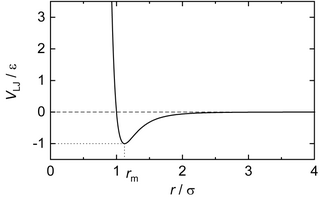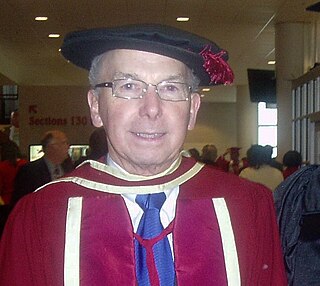
In physics and chemistry, an equation of state is a thermodynamic equation relating state variables, which describe the state of matter under a given set of physical conditions, such as pressure, volume, temperature, or internal energy. Most modern equations of state are formulated in the Helmholtz free energy. Equations of state are useful in describing the properties of pure substances and mixtures in liquids, gases, and solid states as well as the state of matter in the interior of stars.

In computational chemistry, the Lennard-Jones potential is an intermolecular pair potential. Out of all the intermolecular potentials, the Lennard-Jones potential is probably the one that has been the most extensively studied. It is considered an archetype model for simple yet realistic intermolecular interactions.
Benjamin Widom is the Goldwin Smith Professor of Chemistry at Cornell University. His research interests include physical chemistry and statistical mechanics. In 1998, Widom was awarded the Boltzmann Medal "for his illuminating studies of the statistical mechanics of fluids and fluid mixtures and their interfacial properties, especially his clear and general formulation of scaling hypotheses for the equation of state and surface tensions of fluids near critical points."

In chemical thermodynamics, isothermal titration calorimetry (ITC) is a physical technique used to determine the thermodynamic parameters of interactions in solution. It is most often used to study the binding of small molecules to larger macromolecules in a label-free environment. It consists of two cells which are enclosed in an adiabatic jacket. The compounds to be studied are placed in the sample cell, while the other cell, the reference cell, is used as a control and contains the buffer in which the sample is dissolved.
Edward Armand Guggenheim FRS was an English physical chemist, noted for his contributions to thermodynamics.
Jürgen Gmehling is a retired German professor of technical and industrial chemistry at the Carl von Ossietzky University of Oldenburg.

The non-random two-liquid model is an activity coefficient model that correlates the activity coefficients of a compound with its mole fractions in the liquid phase concerned. It is frequently applied in the field of chemical engineering to calculate phase equilibria. The concept of NRTL is based on the hypothesis of Wilson that the local concentration around a molecule is different from the bulk concentration. This difference is due to a difference between the interaction energy of the central molecule with the molecules of its own kind and that with the molecules of the other kind . The energy difference also introduces a non-randomness at the local molecular level. The NRTL model belongs to the so-called local-composition models. Other models of this type are the Wilson model, the UNIQUAC model, and the group contribution model UNIFAC. These local-composition models are not thermodynamically consistent for a one-fluid model for a real mixture due to the assumption that the local composition around molecule i is independent of the local composition around molecule j. This assumption is not true, as was shown by Flemr in 1976. However, they are consistent if a hypothetical two-liquid model is used.

Daan Frenkel is a Dutch computational physicist in the Department of Chemistry at the University of Cambridge.

In statistical thermodynamics, UNIQUAC is an activity coefficient model used in description of phase equilibria. The model is a so-called lattice model and has been derived from a first order approximation of interacting molecule surfaces. The model is, however, not fully thermodynamically consistent due to its two-liquid mixture approach. In this approach the local concentration around one central molecule is assumed to be independent from the local composition around another type of molecule.
PSRK is an estimation method for the calculation of phase equilibria of mixtures of chemical components. The original goal for the development of this method was to enable the estimation of properties of mixtures containing supercritical components. This class of substances cannot be predicted with established models, for example UNIFAC.
The Bromley equation was developed in 1973 by Leroy A. Bromley with the objective of calculating activity coefficients for aqueous electrolyte solutions whose concentrations are above the range of validity of the Debye–Hückel equation. This equation, together with Specific ion interaction theory (SIT) and Pitzer equations is important for the understanding of the behaviour of ions dissolved in natural waters such as rivers, lakes and sea-water.

Keith E. Gubbins is a British-born American chemical engineer who is the W.H. Clark Distinguished University Professor of Chemical Engineering at North Carolina State University in Raleigh, North Carolina. He is perhaps best known as one of the originators of statistical associating fluid theory (SAFT).
VTPR is an estimation method for the calculation of phase equilibria of mixtures of chemical components. The original goal for the development of this method was to enable the estimation of properties of mixtures which contain supercritical components. These class of substances couldn't be predicted with established models like UNIFAC.
PC-SAFT is an equation of state that is based on statistical associating fluid theory (SAFT). Like other SAFT equations of state, it makes use of chain and association terms developed by Chapman, et al from perturbation theory. However, unlike earlier SAFT equations of state that used unbonded spherical particles as a reference fluid, it uses spherical particles in the context of hard chains as reference fluid for the dispersion term.
The Mie potential is an intermolecular pair potential, i.e. it describes the interactions between particles at the atomic level.

ms2 is a non-commercial molecular simulation program. It comprises both molecular dynamics and Monte Carlo simulation algorithms. ms2 is designed for the calculation of thermodynamic properties of fluids. A large number of thermodynamic properties can be readily computed using ms2, e.g. phase equilibrium, transport and caloric properties. ms2 is limited to homogeneous state simulations.
Cubic equations of state are a specific class of thermodynamic models for modeling the pressure of a gas as a function of temperature and density and which can be rewritten as a cubic function of the molar volume.
Statistical associating fluid theory (SAFT) is a chemical theory, based on perturbation theory, that uses statistical thermodynamics to explain how complex fluids and fluid mixtures form associations through hydrogen bonds. Widely used in industry and academia, it has become a standard approach for describing complex mixtures. Since it was first proposed in 1990, SAFT has been used in a large number of molecular-based equation of state models for describing the Helmholtz energy contribution due to association.
Amparo Galindo is a Spanish chemist who is Professor of Chemical Engineering at Imperial College London. She is the co-director of the Institute for Molecular Science and Engineering. Her research considers the development of statistical mechanics and simulations to understand industrial processes. She was awarded the 2023 Institution of Chemical Engineers Guggenheim Medal.







